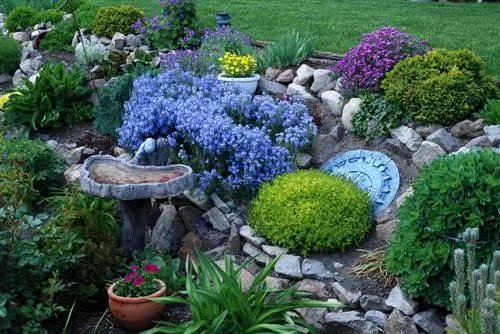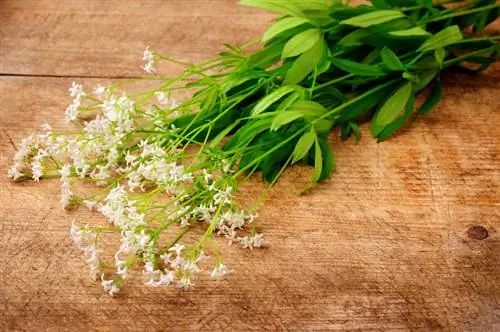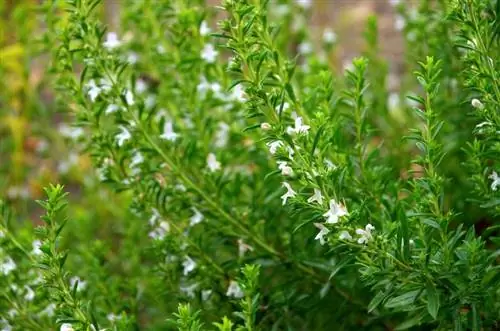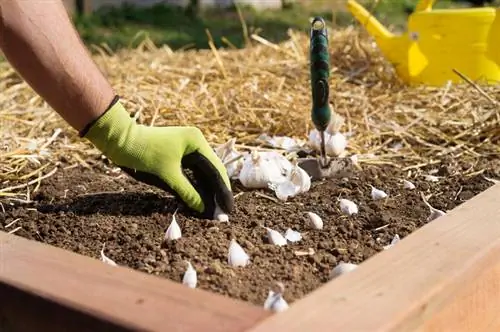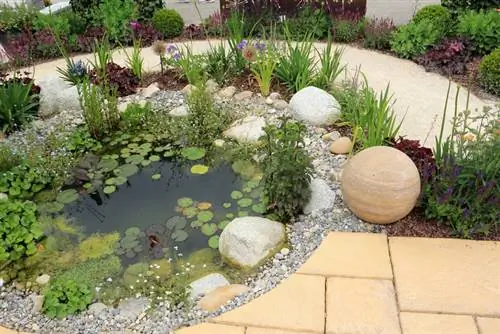- Author admin [email protected].
- Public 2023-12-26 14:17.
- Last modified 2025-06-01 06:02.
An embankment - also known as a slope - is characterized by its steepness. The steeper such a slope is, the sooner it needs to be fortified. There are various options available to you: You can secure an embankment with walls, but you can also protect it from erosion through clever planting.
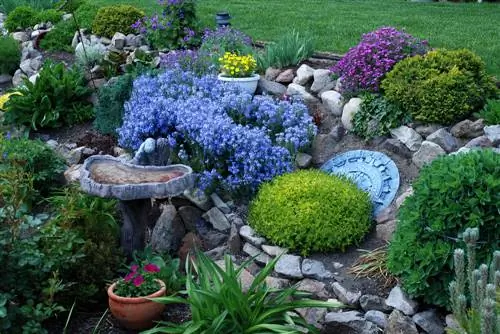
How can you secure and stabilize an embankment?
An embankment can be secured by building walls or planting. Suitable materials for walls are wood, natural stone or concrete. Planting with deep-rooted perennials, shrubs and ground covers helps prevent erosion and stabilize the slope.
Fixing the embankment - you have these options
Fixing a slope with walls is always necessary if there are height differences between different properties or if there are steep slopes on a property. The concrete industry offers a wide variety of components for this purpose, although embankments can of course also be secured using traditional natural stones or wooden components.
Wall types and materials
In this section you will find out which materials are available to you for fixing such a slope using a wall. Remember that walls generally require a concrete foundation so that the structure is stable and can withstand the pressure of the slope.
Wood
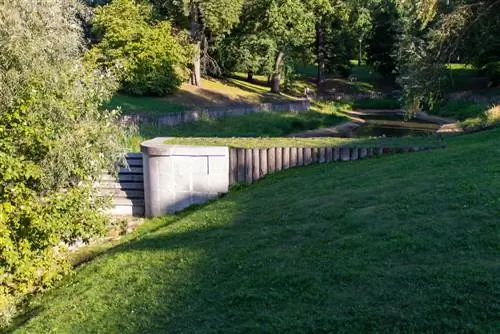
Wood is a beautiful, but rather weather-sensitive material for embankment reinforcement
Wooden retaining walls consist primarily of sleepers or round timbers, which are mostly made from European types of wood. They are beautiful to look at, but have a limited shelf life. The critical point lies in the humid zone between earth and air, where the wood is primarily destroyed. Later coats to protect the wood are of no use, at best you can delay the rotting process by using a deeply impregnated pre-treated wood.
Suitable materials for wooden retaining walls
Boiler pressure-impregnated sleepers or palisades are well suited for embankments. The special boiler pressure process achieves depth protection of up to one centimeter. As a rule, they are saline solutions that are odorless and give the wood a greenish-brown appearance. This chemical protection, especially against fungal attack, is essential when wood comes into contact with soil.
Wood is susceptible to rot
Since sleepers and round timbers have to be stuck vertically in a concrete foundation in order to withstand earth pressure, the transition point between wood and floor is particularly susceptible to rot. This is the weak point of even the most well-impregnated wood, because the accumulated water penetrates the wood at these points. A layer of roofing felt or foil on the earth-filled side is of no use either. Given this problem, wooden walls should not be planned as permanent terrain supports - unless you want a new garden after 15 years and are therefore happy if something breaks.
Drystone walls
Building a small-scale stone wall as a dry stone wall without binding agents in the joints is best achieved with regularly processed natural stones that are embedded deep into the slope. The wall should “lean against the slope” and also be at least a third as wide in the lower area as it is high.
This is what you need to pay attention to with a supporting drywall:
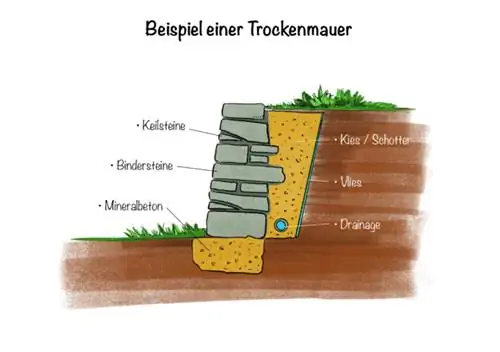
The stones are incorporated into the backing. This means that the dry stone wall made of natural stone remains stable over a long period of time and grows lushly over time. Layering concrete embankment stones on top of each other also creates a type of dry stone wall. It is important to stagger the stones back slightly so that planting holes are created that absorb rainwater. In addition, the stability of the wall increases if it leans slightly diagonally against the slope.
Concrete walls
Concrete stones are available in many shapes and colors, some even look very similar to natural stones. Such concrete consists of colored material or admixtures of colorful natural stone chippings. In many systems there are matching shaped stones such as corners, angles, foot and head parts as well as end stones for these stones, comparable to a building block. The construction is then relatively simple, but requires precise planning of the required molded parts.
Drawing makes planning easier
When purchasing materials for such a wall, you always have a drawing drawn up beforehand, which should then show the amount of material. The stones for such walls are delivered as ready-split individual stones and only need to be placed on top of each other, whereby the lowest layer should of course rest on a frost-proof concrete foundation.
Retaining walls made of hollow blocks
Hollow blocks made of aerated concrete, such as those used to build houses, can also be used to build retaining walls. The disadvantage of them is that they are not very attractive and the wall created in this way then still has to be plastered. The advantage of such stones, however, is that such a wall can be built very quickly due to the size of the stone.
L-stones made of concrete
Formed concrete blocks are heavy, L-shaped elements that are usually used as a retaining wall or to fortify slopes. They come in different heights, although the larger ones are often so heavy that they can only be put in place with the help of a crane. On the other hand, because of their large contact surface, they do not require a deep concrete foundation and can be placed directly on a gravel bed with leveling concrete.
Excursus
What are embankment stones?
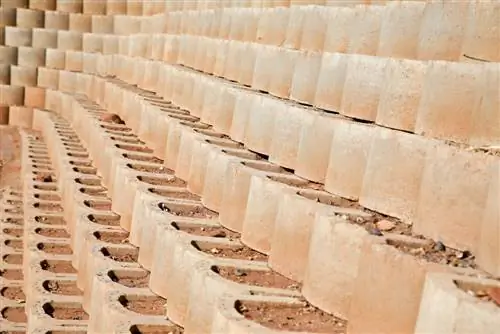
Embankment stones not only strengthen the slope, they can also be easily planted
Concrete embankment stones are manufactured specifically for securing slopes. These are open and very coarse-pored, horseshoe-shaped, round or square concrete blocks that are placed on top of each other in layers. They are available in concrete gray or sandstone red in different sizes. If several of these stones are placed on top of each other, the cavities only have to be filled with stone material or concrete. Walls made of embankment stones appear very solid.
Observe building and neighborhood laws
As so often in life, the rights of others must be taken into account when building a wall. This is intended to prevent neighbors from suffering disadvantages. It is helpful to deal with the legal restrictions during planning, instead of having to interrupt or even stop work later during construction.
Different regulations
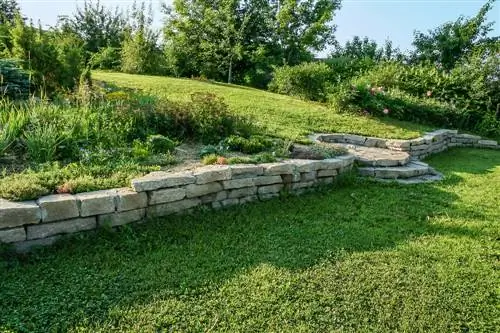
Sometimes a permit is required for embankment reinforcement
In most federal states, the provisions of neighboring law, which were developed from the Civil Code (BGB), apply. The regulations are very different and sometimes even differ from municipality to municipality, which is why, when planning such construction work, you should ask the local building authority for advice or take a look at the municipal building regulations.
In Baden-Württemberg, for example, this rule applies to retaining walls: If, for example, your own site is excavated, i.e. deepened compared to the neighbor's, either an embankment or a wall must support the neighboring site. The wall can then stand directly on the border as long as it does not exceed 150 centimeters in height. If the area is filled up, i.e. raised compared to the neighbor, the same applies: embankments or walls up to 150 centimeters high end directly at the property line.
Decorate walls
Whether a wall should be decorated or not depends on the building material used, the type of construction and the taste of the garden owner. In the case of natural or various artificial stone walls with varied surface structures and joints, there is no need for additional decoration because their surface is already attractive enough. The situation is different with raw materials such as hollow blocks, molded concrete parts or aerated concrete slabs. Such walls are usually
- plastered,
- colored,
- or by lining with more noble stone material (natural stone, clinker, ceramic)
beautified. One of the classic methods is probably the well-known exposed aggregate concrete. If you already have an unsightly wall that cannot be improved by plastering or painting, planting a fast-growing climbing plant usually helps. A distinction is made between self-adhering plant species and those that require climbing assistance. This is attached to the wall surface as a trellis. Please note the growth conditions necessary for the plants, such as soil or light conditions.
Planting embankments - The other type of slope reinforcement
Embankments can not only be fortified with walls, but also secured with the help of plants. This is especially true for slopes that are not too steep and are primarily intended to be protected from soil erosion. For this purpose, choose deep-rooted perennials, shrubs and ground covers that practically hold the soil on the slope. Ground cover plants in particular do a good job here, as they basically act like a safety net.
This article shows how you can plant an embankment imaginatively and use it multiple times:
video: Youtube

Suitable plants
Which plants are specifically suitable for planting on a slope depends on various factors. The lighting and ground conditions, as well as the degree of inclination and the orientation towards the sky, determine the selection. By the way, so-called planting mats, which are simply applied, have proven to be effective on particularly steep slopes. Place the plants in the soil into the holes pre-punched there, whereby the young plants are fixed to the slope by the mats and thus have a better hold until they grow successfully. We would like to introduce you to some particularly suitable species here.
Perennials
Perennials are perennial plants whose above-ground plant parts usually freeze back in the winter months and sprout again vigorously in spring. Many combinations are possible here, depending on the composition of the soil and the light available on the slope. In principle, however, the plants should be very robust, because the living conditions on an embankment are not easy: As a rule, the areas higher up are more likely to be characterized by dryness, as rainwater always runs down and then collects at the foot of the slope - at this So it is rather damp in places.
What you need to pay attention to when planting a slope
Choose the planting accordingly: Plant drought-loving and light-hungry plants higher up, while plants with a higher need for moisture feel more comfortable further down. Mulch the soil after planting as this has an additional protective effect and counteracts erosion.
Shrubs
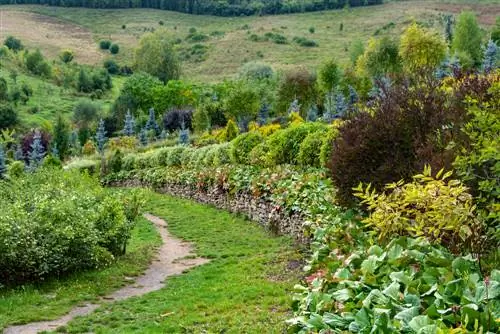
Low shrubs and bushes are ideal for natural slope reinforcement
Deep-rooted shrubs can even be used to strengthen steep slopes, especially if you combine them with ground cover plants. These trees are particularly recommended for this purpose:
- Broom (Cytisus scoparius): pretty, bright yellow flowers
- Boxwood (Buxus): very tolerant of pruning, but threatened in some regions by the boxwood borer
- Firethorn (Pyracantha): beautiful fruit decoration in bright colors
- Cinquefoil (Potentilla fruticosa)
- Dog roses (Rosa canina): native shrub rose, grows two to three meters high
- Cornelian cherry (Cornus mas): branches well, therefore forms dense areas, heavy pruning causes willing shoots, lime-loving
- Creeping juniper (Juniperus communis 'Repanda')
- Privet (Ligustrum): robust, tolerates strong shade, evergreen, can be cut back to the base
- Buddleia (Buddleja)
- Holly (Ilex): can grow up to six meters high
- Ornamental quince (Chaenomeles)
- Cotoneaster
Groundcover
Ground cover plants are particularly suitable for planting on slopes, as they hold the slope together like a net and also spread out on their own over time. Particularly recommended are species such as
- Lady's Mantle (Alchemilla mollis)
- the different cranesbill species (Geranium)
- Golden nettle (Lamium galeobdolon)
- Waldsteinia (also “golden strawberry”, Waldsteinia ternata)
- Fairy Flower (Epimedium)
- Carpet St. John's wort (Hypericum calycinum)
- Ysander (Pachysandra)
- Ivy (Hedera helix)
The last three species are evergreen and retain their green foliage even during the gray winter months.
Excursus
Laying turf on a slope - this is how it works
Rolled turf is also suitable for fixing a slope, at least once it has grown. On slopes, you should always lay the sod across the slope and from bottom to top. The sheets press together under their own weight and do not form any joints. Driven wooden dowels secure the lawn parts until they have grown. Every subsequent maintenance measure on the slope must be carried out carefully in order not to cause unrooted sod to slide.
Frequently asked questions
What is the best way to mow an embankment?
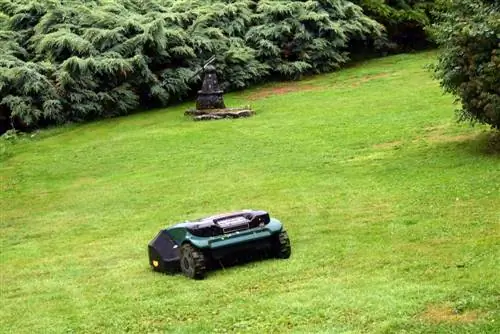
Grass on slopes must not be cut too short
Embankments should always be mowed across the slope. A maximum of one third of the leaf mass may also be removed. It is difficult for the plants to compensate for further loss of mass; they become weakened and susceptible to disease. The deeper the cut, the better the quality of the soil and the supply of water and nutrients must be. Always mow with a wheel width overhang so that you get a seamless, streak-free cutting surface.
How can I make the retaining wall as stable as possible?
Experts like to plan a cantilevered foundation to counteract the tipping moment. This has the disadvantage that nothing can be planted in front of the wall. However, by eliminating this projection and widening the foundation into the slope, this restriction can be avoided. Instead, you practically build the wall “into the slope”, which gives the construction the necessary stability.
Can I also build the retaining wall out of Corten steel?
Buildings made of Corten steel are durable, do not “rust” in a damaging way like normal steel and therefore do not require any anti-rust coating. In terms of construction, these terrain supports are surprisingly simple: you have to insert the (prefabricated) metal parts into a concrete foundation and anchor them together using screws. However, the steel plates must be supported until the foundation concrete is solid.
Tip
If the slope is very steep, it is best to create several terraces, each supported by low walls. You can plant these terraces however you like or set them up as completely different garden rooms. Terrace gardens have been around for thousands of years and are still widespread today, especially in mountainous regions.

